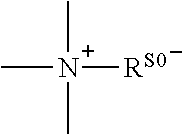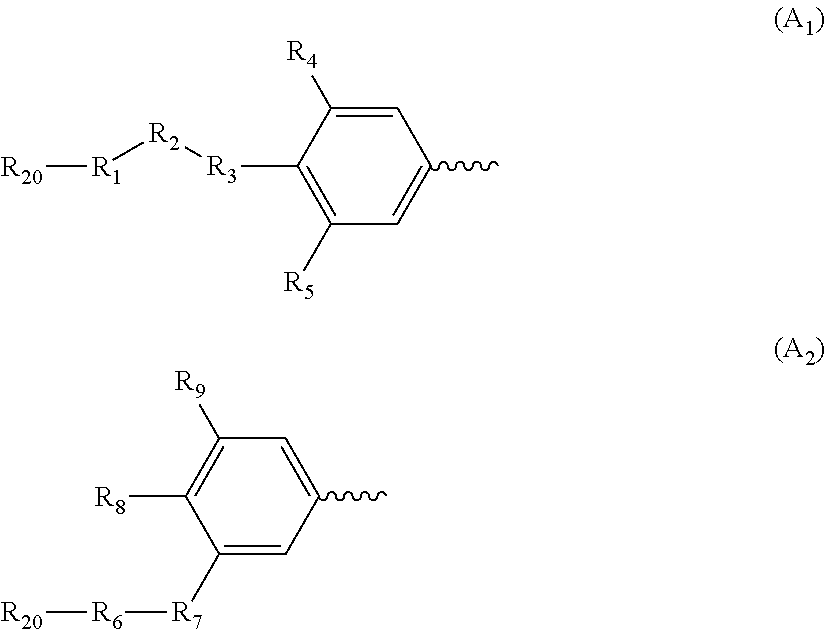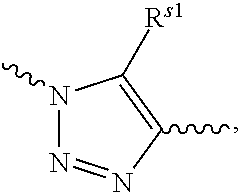Conjugate of polyethylene glycol and anesthetic, and preparation method thereof
a polyethylene glycol and anesthetic technology, applied in the field of medical technology, can solve the problems of affecting the function and physical recovery of the digestive system, accelerating the heart rate, and jerky breath, and achieve the effect of prolonging the duration of anesthetics, effective playing the role of anesthetics, and high stability
- Summary
- Abstract
- Description
- Claims
- Application Information
AI Technical Summary
Benefits of technology
Problems solved by technology
Method used
Image
Examples
example 1
Synthesis of Linking Chain (L1)
[0220]
[0221]4-pentynoic acid (2.0 g, 20 mmol) and N, N-dicyclohexylcarbodiimide (DCC, 5.2 g, 2.5 mmol) were added to dichloromethane (50 mL), cooled in an ice-water bath, then p-hydroxybenzaldehyde (2.68 g, 22 mmol) was added, the ice-water bath was removed after completion of addition, and the resulting mixture was reacted at room temperature overnight, and filtered, the filter cake was washed with ethyl acetate and the filtrate was evaporated to dryness to obtain a crude product, which was purified by column chromatography to give 3.5 g of product 1a.
[0222]The compound 1a (3.23 g, 16 mmol) was added to anhydrous methanol (35 mL), cooled to 0° C., then sodium borohydride (365 mg, 9.6 mmol) was added, the reaction was carried out at the same temperature for 10 min and then quenched with 1 M HCl, the resulting mixture was subjected to rotary evaporation to remove methanol, and further added with ethyl acetate and saturated brine, the aqueous phase was e...
example 2
Synthesis of Quaternary Ammonium Salt of Lidocaine (Y1)
[0224]
[0225]Lidocaine (0.50 g, 2.13 mmol) and compound L1 (1.0 g, 3.19 mmol) were added to acetonitrile (20 mL) and reacted at 50° C. overnight. TLC monitoring showed that the lidocaine was reacted completely, and the reaction liquid was concentrated to give a crude product, which was purified by column chromatography to give 1.2 g of product Y1. 1H-NMR: (CDCl3): 1.59 (m, 6H), 2.06 (s, 2H), 2.31 (s, 6H), 2.64 (m, 2H), 2.87 (m, 2H), 3.49 (m, 2H), 3.71 (m, 2H), 4.89 (s, 2H), 4.93 (s, 2H), 7.06 (m, 3H), 7.28 (d, 2H), 7.62 (d, 2H), 9.79 (s, 1H).
example 3
Synthesis of Conjugate 1 of Lidocaine (mPEG-Lidocaine, 20 K)
[0226]
[0227]mPEG-N3 (20 K, 2 g, 0.1 mmol), compound Y1 (65.8 mg, 0.12 mmol), vitamin C (52.8 mg, 3 mmol) were added to N, N-dimethylformamide (20 mL), the resulting mixture was rapidly stirred to dissolve, then added with an aqueous solution (4.4 mL, 2.2 mL / g PEG) of copper sulfate pentahydrate (30 mg, 0.12 mmol), the resulting mixture was reacted at room temperature overnight and precipitated with isopropanol to give 1.9 g of product. 1H NMR: (CDCl3): 1.42 (m, 6H), 2.19 (s, 6H), 3.02 (m, 4H), 3.23 (m, 4H), 3.31 (s, 3H), 3.50 (m, 1800H), 3.80 (m, 2H) (m, 2H), 4.20 (m, 2H), 4.50 (s, 2H), 4.82 (s, 2H), 7.12 (m, 3H), 7.30 (d, 2H), 7.64 (d, 2H) s, 1H), 10.28 (s, 1H).
PUM
| Property | Measurement | Unit |
|---|---|---|
| temperature | aaaaa | aaaaa |
| temperature | aaaaa | aaaaa |
| length | aaaaa | aaaaa |
Abstract
Description
Claims
Application Information
 Login to View More
Login to View More - R&D
- Intellectual Property
- Life Sciences
- Materials
- Tech Scout
- Unparalleled Data Quality
- Higher Quality Content
- 60% Fewer Hallucinations
Browse by: Latest US Patents, China's latest patents, Technical Efficacy Thesaurus, Application Domain, Technology Topic, Popular Technical Reports.
© 2025 PatSnap. All rights reserved.Legal|Privacy policy|Modern Slavery Act Transparency Statement|Sitemap|About US| Contact US: help@patsnap.com



